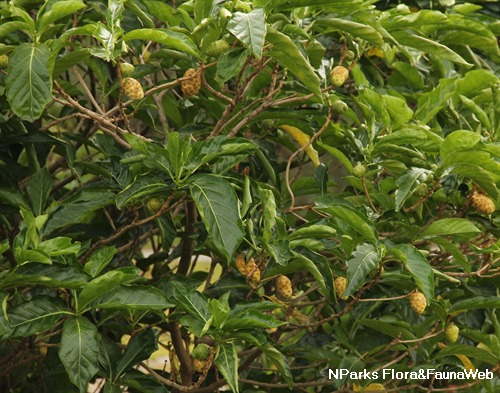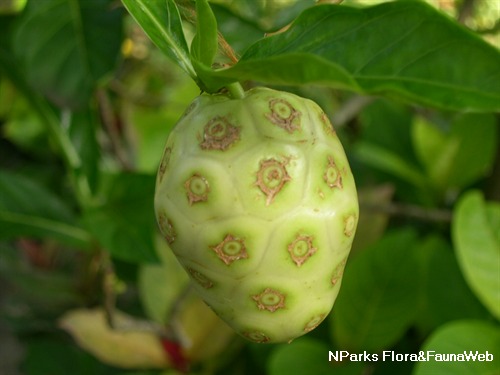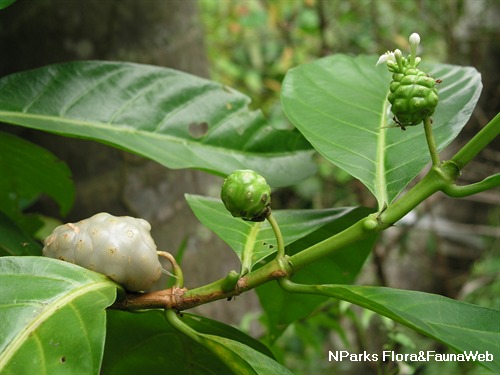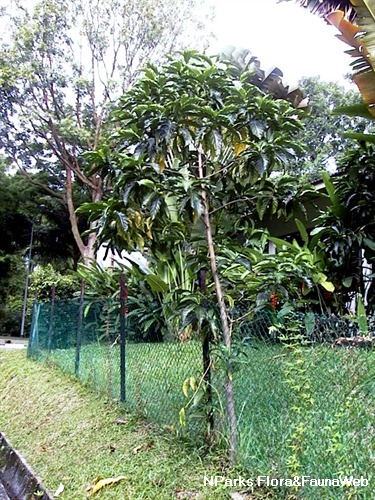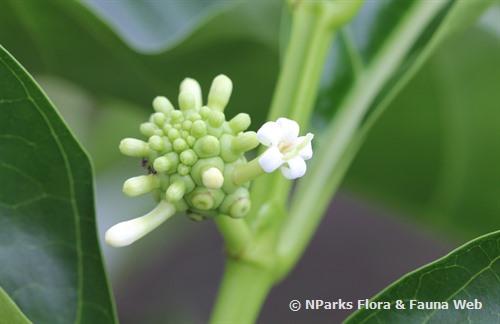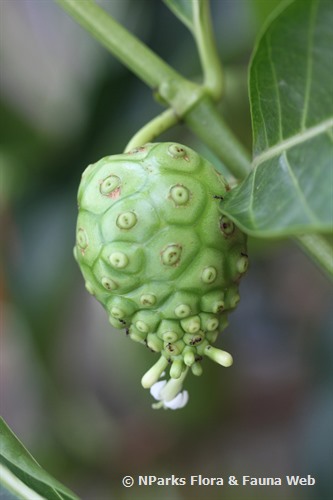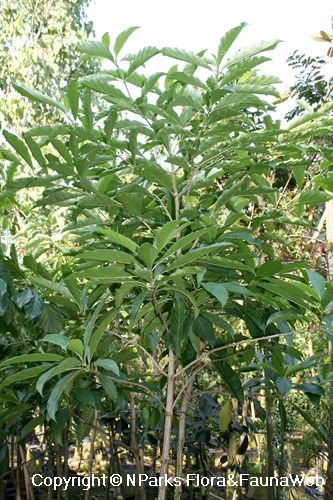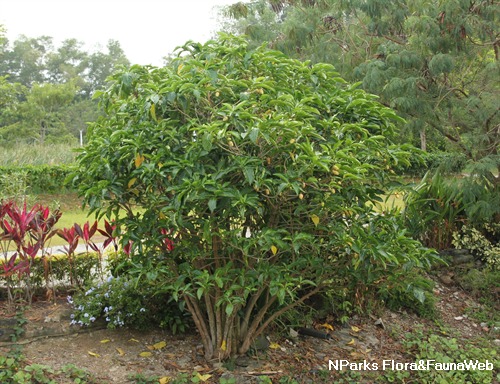
Back
Morinda citrifolia L.
| Family Name: | Rubiaceae |
| Synonyms: | Morinda bracteata, Morinda litoralis Blanco |
| Common Name: | Mengkudu Besar, Inda, Menkudu, Indian Mulberry, Noni, Great Morinda, Cheese Fruit, Mengkudu, Awl Tree, Brimstone Tree, 海滨木巴戟, 海巴戟 |
Name
Classifications and Characteristics
| Plant Division | Angiosperms (Flowering Seed Plants) (Dicotyledon) |
|---|---|
| Plant Growth Form | Tree (Small (6m-15m)) |
| Lifespan (in Singapore) | Perennial |
| Mode of Nutrition | Autotrophic |
| Plant Shape | Conical |
| Maximum Height | 3 m to 10 m |
Biogeography
| Native Distribution | Singapore, Australia, India, Indochina, Southeast Asia, Pacific |
|---|---|
| Native Habitat | Terrestrial (Secondary Rainforest, Monsoon Forest, Coastal Forest), Shoreline |
| Preferred Climate Zone | Tropical, Sub-Tropical / Monsoonal |
| Local Conservation Status | Native to Singapore (Least Concern (LC)) |
Description and Ethnobotany
| Growth Form | Small trees or shrubs, 3 - 10 m tall when mature. |
|---|---|
| Foliage | Leaves opposite and glossy, blades membraneous, elliptic to elliptic-ovate and glabrous, petioles stout, stipules connate or distinct. |
| Flowers | Flowers perfect, about 75 - 90 in ovoid to globose heads. |
| Fruit | Fruits are yellowish-white, fleshy, soft and fetid when ripe. |
| Habitat | Occurs on dry to mesic sites 0 - 500m in elevation, can be found in brackish pools near the coast, open areas near the shorelines and disturbed forests. |
| Associated Flora | Usually associated with common coastal and littoral forest shrubs and tree species in its native habitat. |
| Etymology | The botanical name for the genus was derived from the two Latin words morus, mulberry, and indicus, Indian, in reference to the similarity of the fruit of Indian mulberry to that of the true mulberry (Morus alba). The species name indicates the resemblance of the plant foliage to that of some citrus species. |
| Ethnobotanical Uses | Medicinal: In Chinese medicine, it is used to contain fever and as a tonic. The plant is similarly used in Japan. A Southeast Asian plant, it is commonly used in native medicines of the region. In Malaysia, the heated leaves are applied to the chest and abdomen to treat coughs nausea, colic and enlarged spleen. In Philippines, the juice of the leaves is given for arthritis. In Indochina, the fruit are prescribed for lumbago, asthma and dysentery. Timber & Products: In ancient times, the bark and the roots are used as colour dyes. |
Landscaping Features
| Desirable Plant Features | Fragrant (Flowers) |
|---|---|
| Landscape Uses | Parks & Gardens, Small Gardens, Beachfront / Shoreline |
| Usage Hazard - Cons | Pungent Scent - Fruits, Invasive / Potentially Invasive |
Fauna, Pollination and Dispersal
| Fauna Pollination Dispersal Associated Fauna | Bird-Attracting, Bat Food |
|---|---|
| Pollination Method(s) | Biotic (Fauna) (Insects (Bee)) |
| Seed or Spore Dispersal | Abiotic |
Plant Care and Propagation
| Light Preference | Full Sun |
|---|---|
| Water Preference | Moderate Water |
| Plant Growth Rate | Moderate |
| Rootzone Tolerance | Drought Tolerant, Waterlogged Soils, Poor Infertile Soils, Acidic (low pH) Soils, Alkaline high pH Soils |
| Pest(s) | Sucking Insects |
| Propagation Method | Seed |
Foliar
| Foliage Retention | Evergreen |
|---|---|
| Mature Foliage Colour(s) | Green |
| Mature Foliage Texture(s) | Smooth |
| Foliar Type | Simple / Unifoliate |
| Foliar Arrangement Along Stem | Opposite |
| Foliar Attachment to Stem | Petiolate |
| Foliar Shape(s) | Non-Palm Foliage (Lanceolate, Elliptical) |
| Foliar Venation | Pinnate / Net |
| Foliar Margin | Entire |
| Foliar Apex - Tip | Acute, Acuminate |
| Foliar Base | Cuneate |
| Leaf Area Index (LAI) for Green Plot Ratio | 3.0 (Tree - Intermediate Canopy) |
Floral (Angiosperm)
| Flower Colour(s) | White |
|---|---|
| Flower Grouping | Cluster / Inflorescence |
| Flower Location | Axillary |
Fruit, Seed and Spore
| Mature Fruit Colour(s) | White |
|---|---|
| Fruit Classification | Aggregate Fruit (Syncarp) |
| Fruit Type | Fleshy Fruit |
Image Repository
Others
| Master ID | 1740 |
|---|---|
| Species ID | 3033 |
| Flora Disclaimer | The information in this website has been compiled from reliable sources, such as reference works on medicinal plants. It is not a substitute for medical advice or treatment and NParks does not purport to provide any medical advice. Readers should always consult his/her physician before using or consuming a plant for medicinal purposes. |

